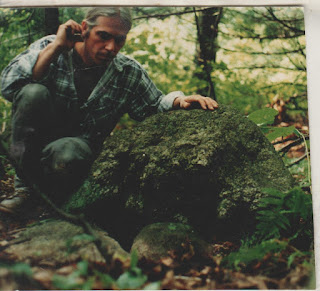“Invested with prayers for the balance of the universe”
As I
understand it, Káhtôquwuk means,
allegorically, a 'Stone Prayer.'
A káhtôquwuk
is a kind of stone pile, a kind of stone heap, something that is heaped high,
ceremonially, religiously, prayerfully, by placing one stone above another stone.
Káhtôquwukansh is the plural of “Stone Prayers.”
Kahtoquwuk in Narragansett, kodtuquag
in Massachusett, Kodtonquag in Nipmuk, and many more variations all mean
"stones that have been stacked up."
Nohham
writes, “There are several types of kodtonquagkash (kodtuhquag in Massachusett),
including effigies. Most kodtonquagkash
are not more than 2 m (6.56 feet) wide and less than 1.8 m. (5.9 feet)
tall. They are usually made in an
organized manner, in several courses of stones, often turret-like in form atop
a base boulder. There are kodtonquagkash
types that are built directly on the forest floor, on shallow bedrock or even
no rock at all.”
In Mohegan Nipawu means “he stands/ stands up,”
in Nipmuc the word is nípaü, as in nípaü kodtonquag – a Stone Prayer
made of either tabular or round stones, stacked in upright courses, sometimes on
top of boulder bases. The plural is nípaü kodtonquagkash, as I
understand it through personal communication with Nohham, who describes these
as apparent “standing “cairns” on rocks,
Nípaü kodtonquag(kash). These are
invested with Prayers for the Balance of
the Universe.”
"At a site
in Shutesbury MA, “94% of intact concentric circle káhtôquwuk are formed from
four to six rings, the center most often being a stone of unusual type (jasper with
contrasting line, pegmatite, quartz crystal or quartz inclusion, leucic
granite, or similar mineral). Center stone is usually quite round or else
pyramidal..."
Hasennnípaü refers
to (a single) stone (that)
stands up, as does sunś
nipámu or ‘marker stone’ in Narragansett,
as found in Ancient Ceremonial Landscape
and King Philip’s War by Harris and Robinson (2015:140), viz. sunś, ‘stone,’
nipawu ‘stand up,’ from
the Mohegan Dictionary (Mohegan Nation, 2004:100, 83) which
sometimes serve as indicators.
And I find Nohham writes that a “Skuguisu káhtqwk refers to a "boulder-based cairn" which is possibly an emerging serpent form…”
One more example, an Obvious Effigy: "Qussuk (Proto Eastern
Algonquian)(singular): a rock/stone
qusanash (PEA)(plural): rocks/stones (PEA) (diminutive
plural): small rocks/stones"
Personal Communication: Al Conley (2020)
From Frank G. Speck:














